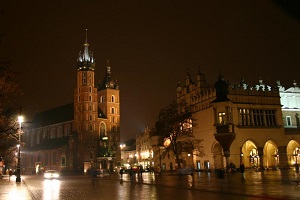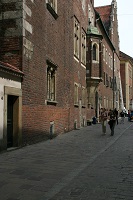Tourist info
Kraków is an old city, with a beautiful medieval old city center. It is very popular and attracts many tourists from all over the world. Some information about places of interest in and around Krakow can be found here: http://www.lonelyplanet.com/poland/malopolska/krakow/sights
 |
 |
 |
 |
The main tourist attractions of Krakow are:
1. The Main Square – it was laid out in accordance with the City Charter, which awarded it rights under the Law of Magdeburg in 1257. It was situated at the crossing of former trade routes forming in plan a square with each side slightly exceeding 200 m (665 ft). The name market square – in Polish Rynek, and originally Ring – was used for the first time around the year 1300. When designing the market square and the area around it, a cross-grid pattern typical of mediaeval cities was introduced. Three streets radiated from each of the sides of the square. From its earliest days, the Main Square played a role as the centre of social and political life, whose significance frequently went far beyond the borders of the city. It provided the backcloth to major historical events in Poland. Rynek Underground Permanent Exhibition is one of the most visited places presenting everyday life of Krakow in Middle Ages: http://www.podziemiarynku.com/index.php?lang=eng.
2. Wawel Castle - is a fortified architectural complex erected over many centuries atop a limestone outcrop on the left bank of the Vistula river in Kraków, Poland, at an altitude of 228 metres above sea level. The complex consists of many buildings and fortifications; the largest and best known of these are the Royal Castle and the Wawel Cathedral (which is the Basilica of St Stanisław and St Wacław). Some of Wawel's oldest stone buildings, such as the Rotunda of the Virgin Mary can be dated to 970AD. There are also wooden parts of the complex which date to about the 9th century. The castle itself has been described as "one of the most fascinating of all European castles.": http://www.krakow.pl/english/visit_krakow/6012,artykul,wawel_royal_castle.html.
3. Collegium Maius - located on the corner of Św. Anny and Jagiellońska Street Collegium Maius, is the oldest university building in Poland. In 1400 King Ladislaus II Jagiello bequeathed a town house to the University, purchased from the town councillor Piotr Gerhardsdorf (Gersdorf). Over the 15th century the college area was increased through the purchase of adjacent houses and the construction of new buildings. After two fires in 1462 and 1492, all the individual houses were joined as one, forming an arcade courtyard surrounded by galleries with the diamond vaults typical for the Late Gothic style. The uniform arcades were interspersed by the "Professor" staircase leading to the first floor balcony. The ground floor housed lectoria, or lecture rooms. Those long rooms with low ceilings were poorly lit and often damp. The library (libraria), the Common Room (Stuba Communis), the treasury and the theologians lecture room (the present-day Aula – assembly hall) were situated on the first floors. The dwellings of professors, or residences, were located on the first and second floors. The Jagiellonian University Museum Collegium Maius: http://www.maius.uj.edu.pl/en_GB/muzeum/historia.
4. The Princes' Czartoryski Museum – is a branch of the National Museum in Kraków. Today, it houses artifacts of ancient art – Egyptian, Greek, Eritrean and Roman, including a sarcophagus from Egypt containing a mummified young woman. The most famous picture kept in the Museum is Leonardo da Vinci’s “Lady with an Ermine”.
5. Kazimierz: Kraków’s Kazimierz is a special place, because it has been shaped by the close neighbourhood of Christianity and Judaism lasting for several centuries. The Jews came to Kazimierz in the 2nd half of the 14th century, and till the first years of the 19th century they had lived there in the separate “Jewish town” whose limits largely followed today’s Miodowa, Św. Wawrzyńca, Wąska, Józefa and Bożego Ciała Streets. It was an autonomous enclave governed by rabbis and elected elders that recognised only the king’s supremacy held on his behalf by the Kraków voivode: http://www.krakow.pl/english/visit_krakow/6316,artykul,jewish_kazimierz.html.
6. Wieliczka salt mines (UNESCO site): The “Wieliczka” Salt Mine is one of the most valuable monuments of material and spiritual culture in Poland. Each year it is visited by more than one million tourists from all over the world. It is also a world class monument, featuring among twelve objects on the UNESCO’s World Cultural and Natural Heritage List. Today, the “Wieliczka” Salt Mine combines many centuries of tradition and modernity, the history of several hundred years and an underground metropolis with extensive infrastructure. The mine is a product of work of tens of generations of miners, a monument to the history of Poland and to the Polish nation – a brand, present in Polish consciousness for centuries: http://www.wieliczka-saltmine.com/
 |
 |
 |
|
Osoba publikująca: Marta Hoffmann